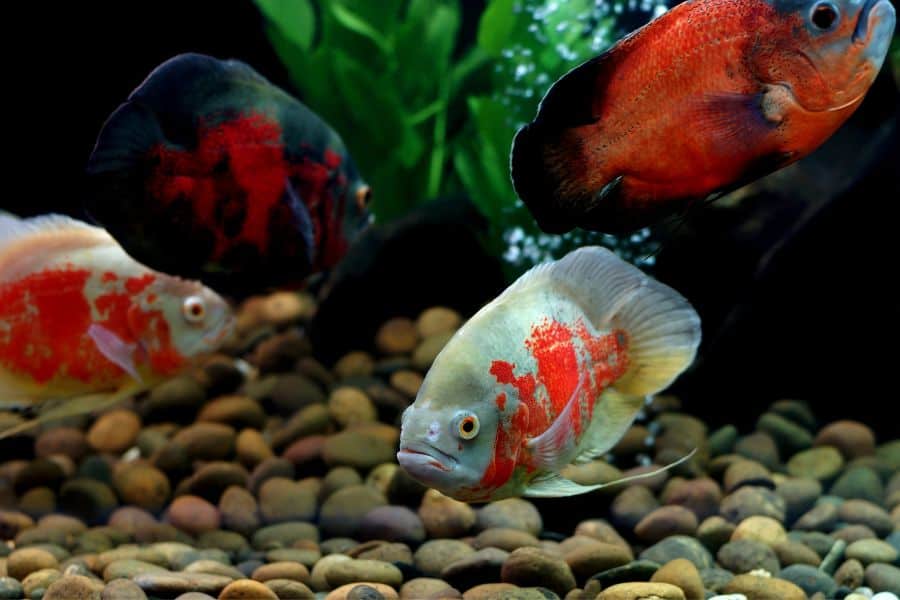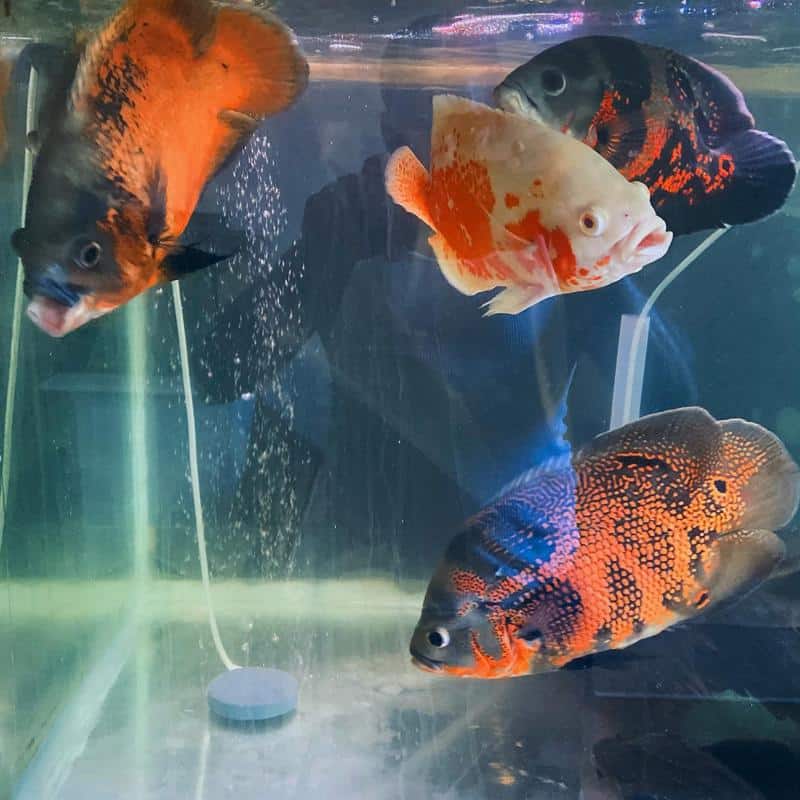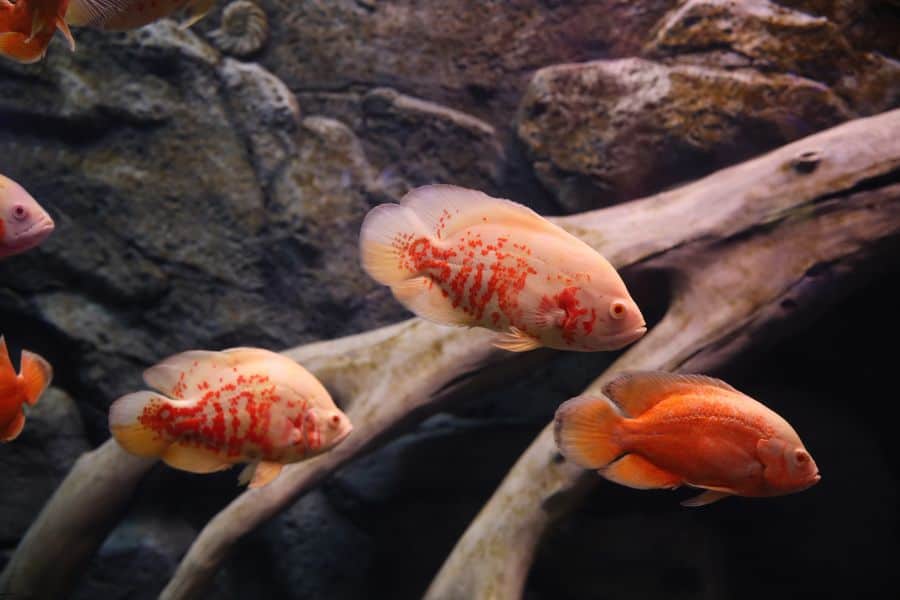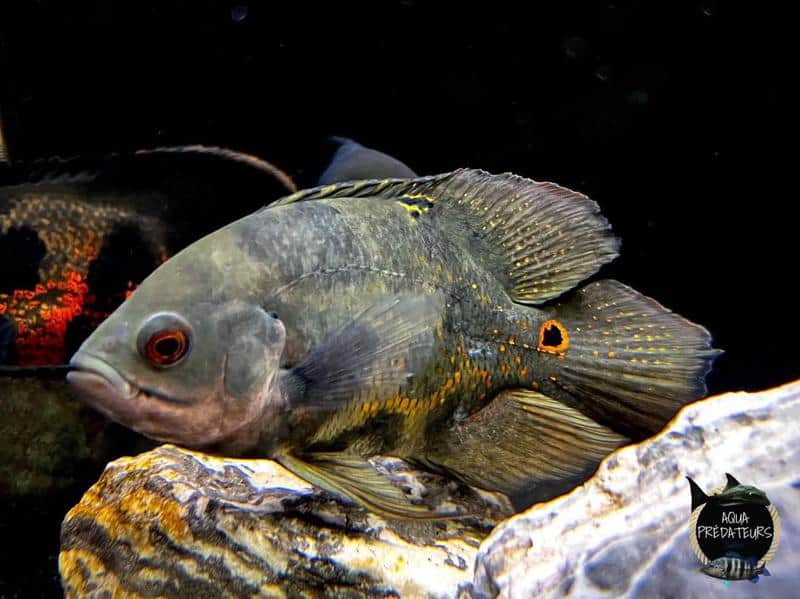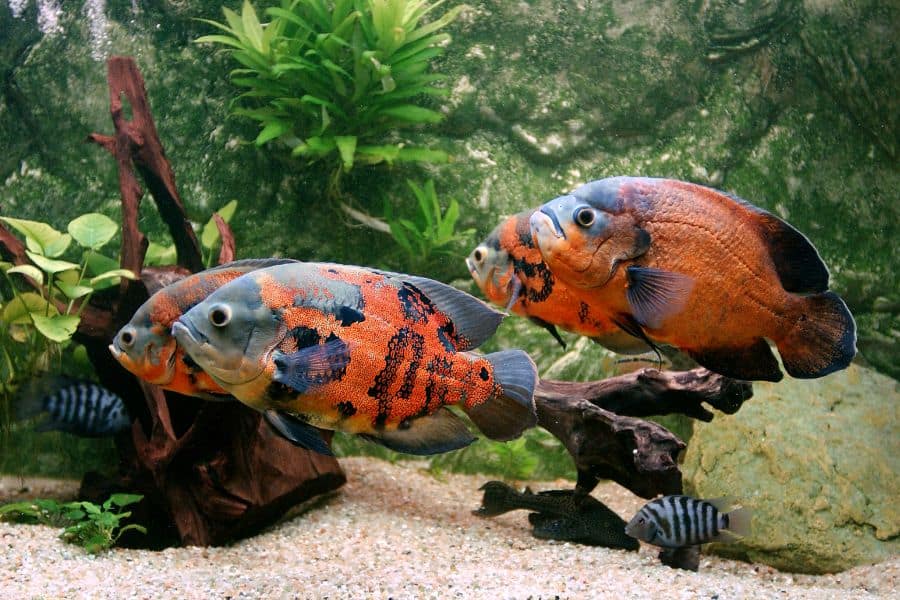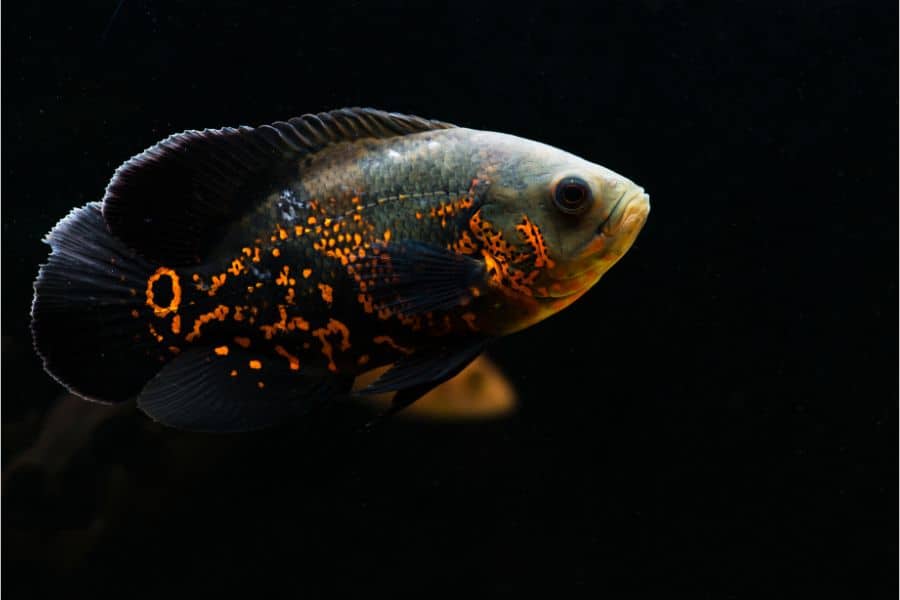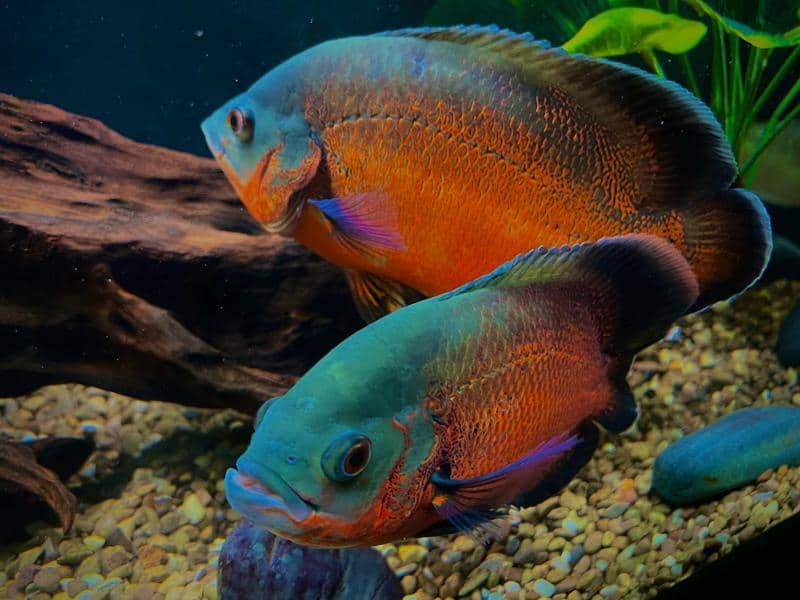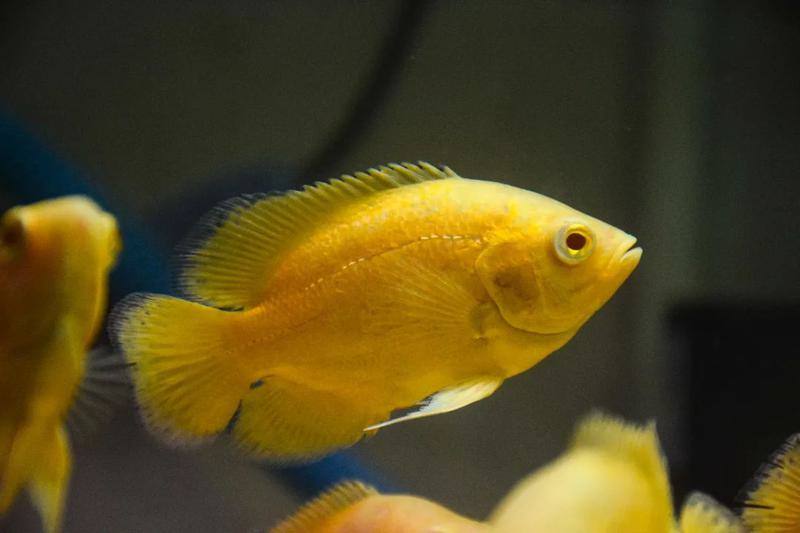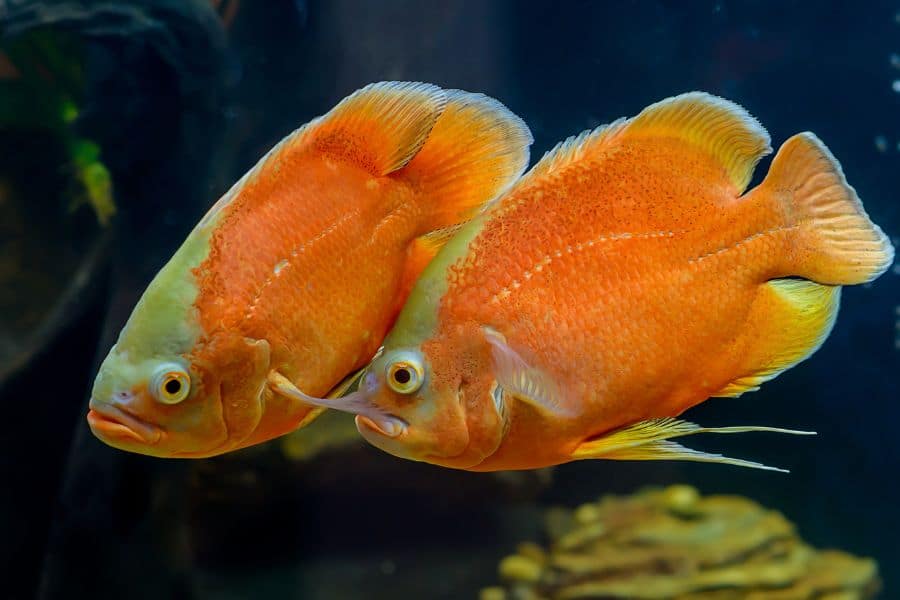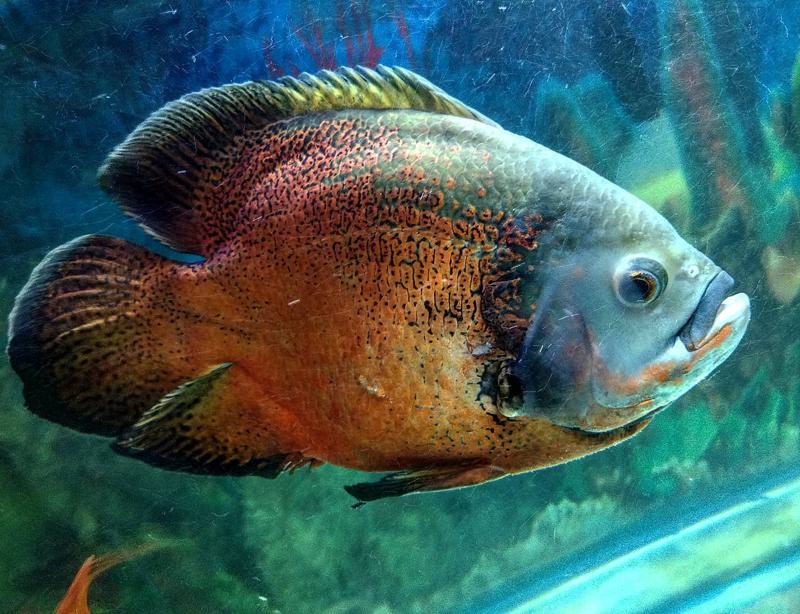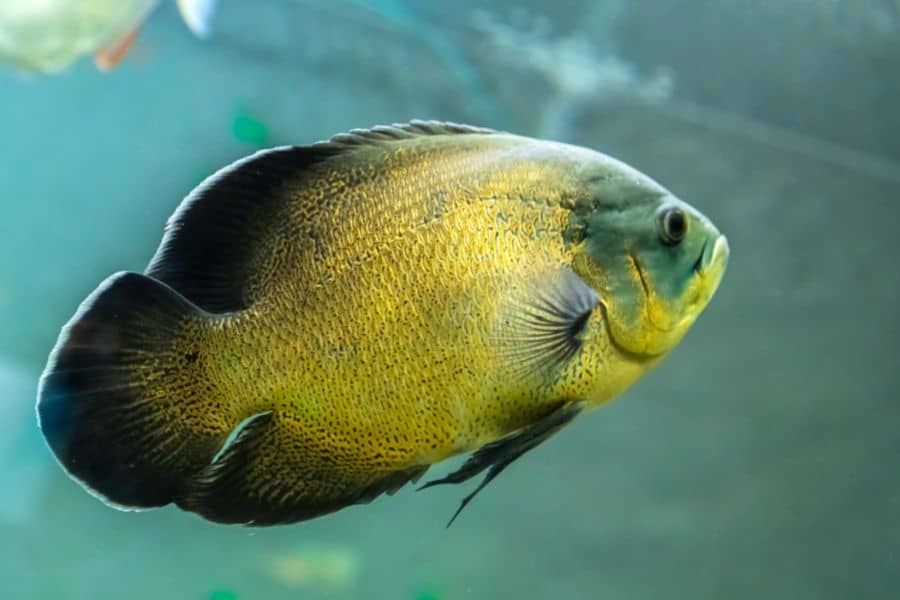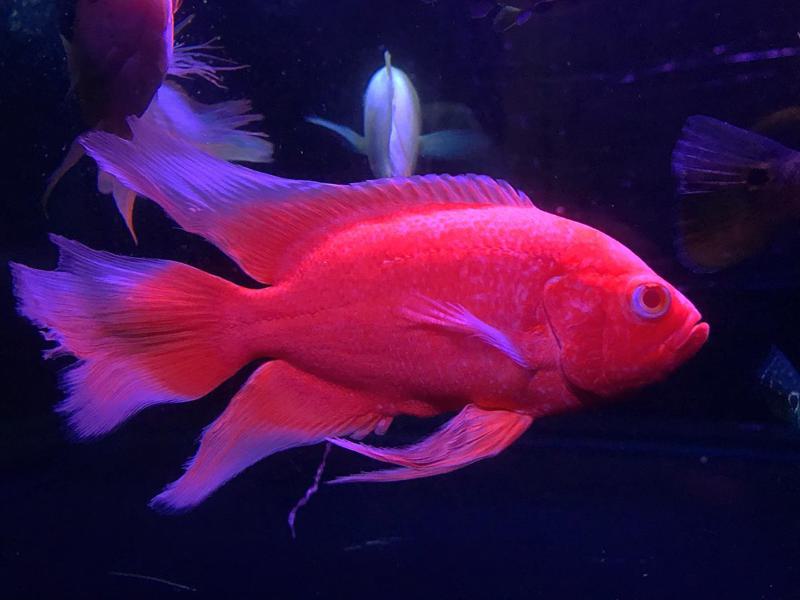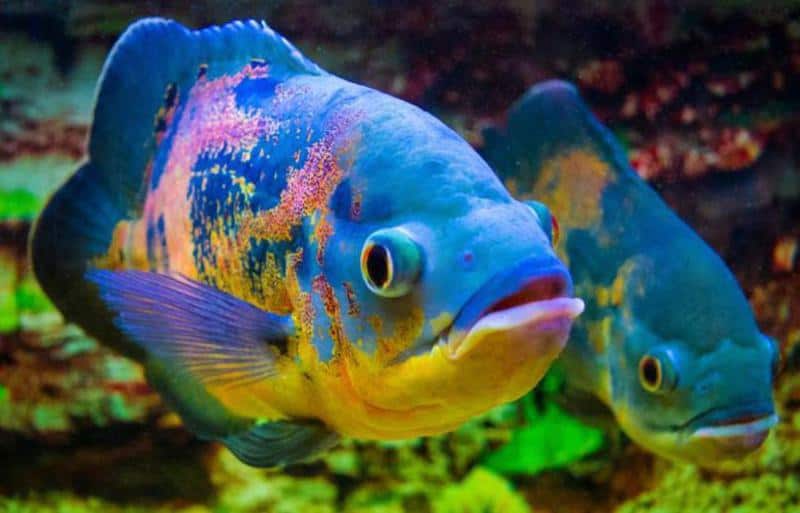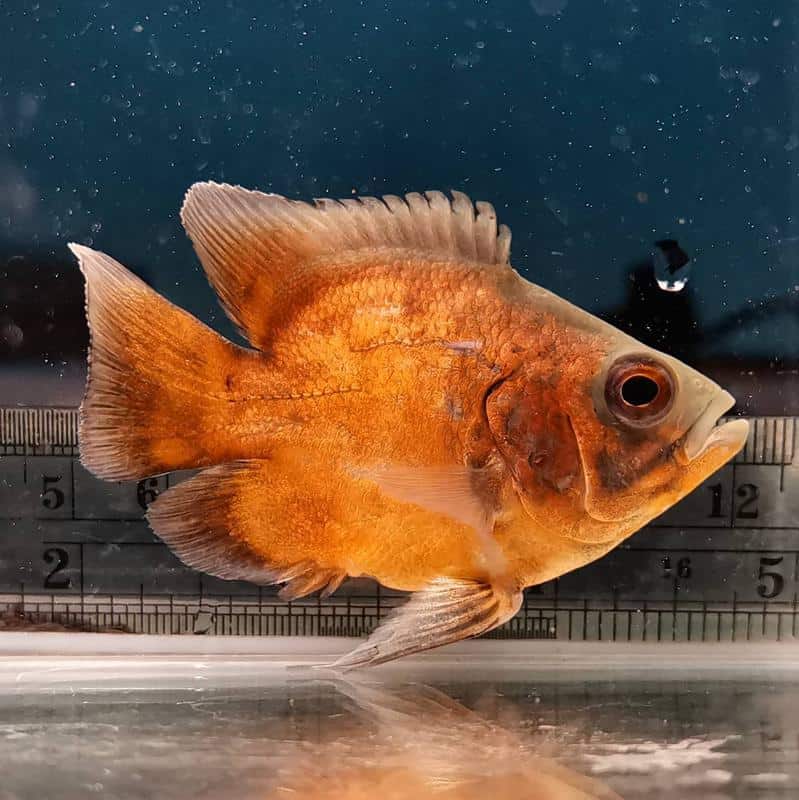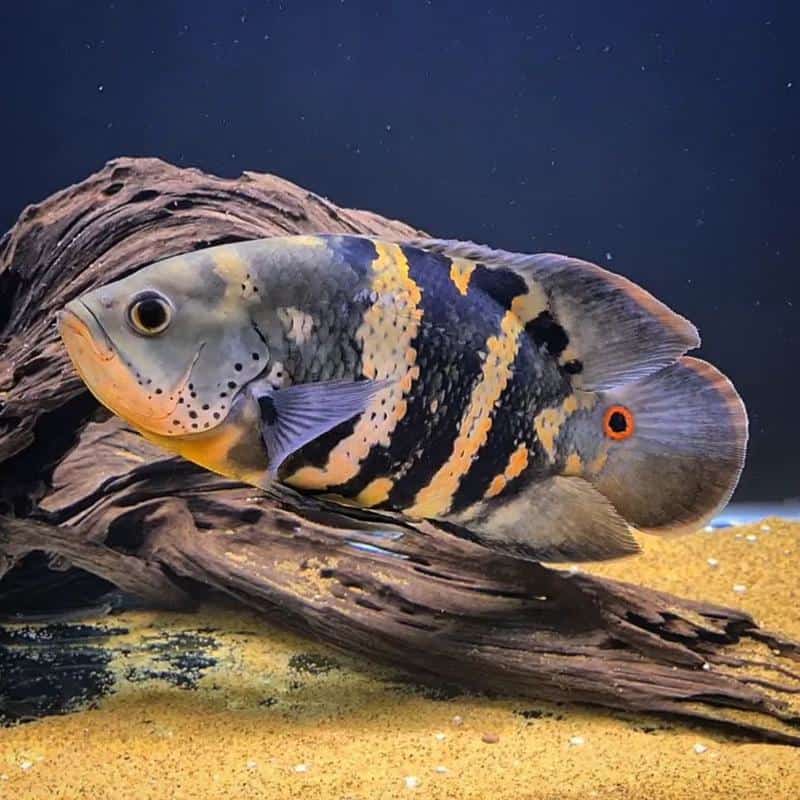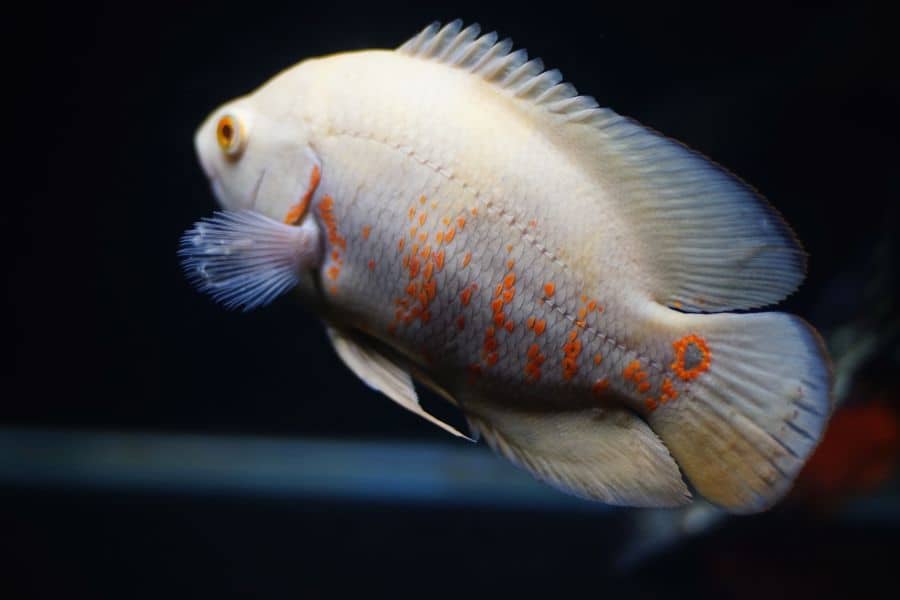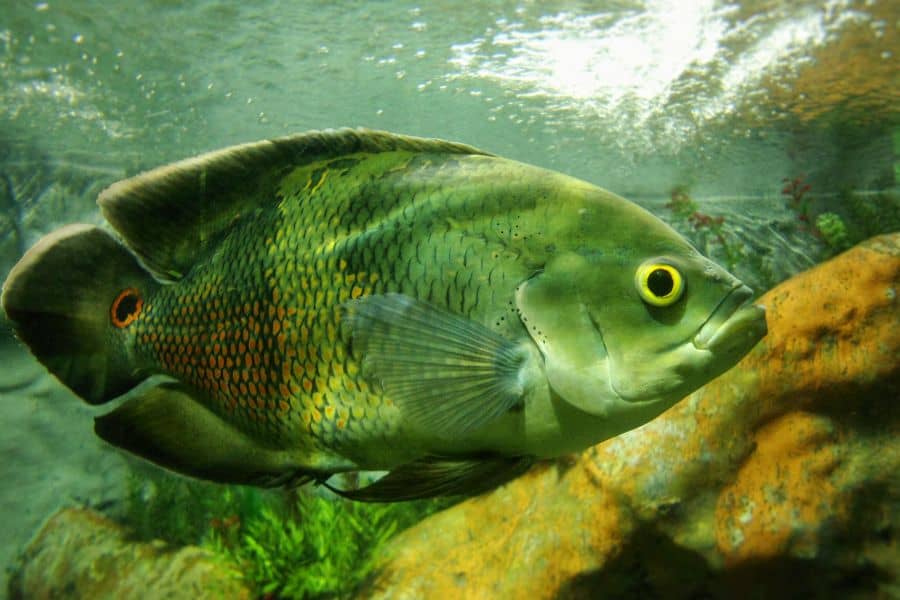Oscar fish commonly referred to as velvet cichlids, is a very well-liked tropical species among sea life hobbyists. They are gorgeous, and watching them swim is quite entertaining.
But, before you take one home, you must understand its basic care and tank requirements. These species are also known as territorial fish, so try to keep them alone or in a separate tank as they might harm other fish.
That’s the main reason that these fish are best-suited for experienced fish keepers. Originally, there used to be just 3 categories of Oscars: red, tiger, and albino.
But nowadays, you may discover Blue, Green, White, Black, and also Veil Tail Oscar as a result of years of cross-breeding.
They are also extremely diversified fish with several varieties. Learn more about the 15 famous Oscar species that may brighten your freshwater tank.
Oscar Overview
The Oscar species (Astronotus ocellatus) are a subgroup of cichlid and belong to the Cichlidae family. This fish was found by scientists in 1831.
They are indigenous to the Cuna de la Democracia, Guarani, Republic of Paraguay, as well as the Amazon River region. They’ve now spread to other countries, such as the United States, China, and Japan.
In the United States, you may discover them in regions like Florida, mostly because of the suitable environment. These species are quite popular in South America due to their unique meat and demand in the aquarium industry.
These species are known to be very clever. Once they are adapted to their unfamiliar environment and get used to living in the tank, they begin to explore their surroundings.
Although Oscar fish have lots of varieties, they grow up to a size between 12-15 inches. They also have an average lifespan of 10-20 years.
They usually stay near the aquarium walls and stare at you and your room. Nevertheless, you’ll see that these species have unique personalities.
Their interesting color scheme and fun personality make oscars among the top tropical species to have in your home tanks. It is also easily accessible, so you won’t have to struggle to locate them. They can be found in your nearby pet shop, reputed breeders, or online fish stores.
We recommend you to check your nearby fish shop before looking for the same fish breed online. It is much easier to detect any problems or illnesses in the fish by examining them.
You can tell if its skin exhibits symptoms of irritation or if its pigment appears dull. It is safer and cheaper to purchase any pet from physical stores.
- Species Family: Cichlidae
- Size: 18 in (45 cm)
- Life expectancy: 10-20 years
- Care level: Intermediate to difficult
- Minimum tank size: 55 gallons
- Diet: Carnivorous
- Temperament: Could be aggressive
- Water temperature: 75-80°F
- Water pH: 6-8
- Water hardness: 12-15dH
Types of Oscar Fish
1. Albino Oscar
You might get the idea from their name that Albino Oscars are of white color. They have a silky surface with sparkling white scales.
This variety comes under the parental category of Oscar fish. You may observe close-knit orange or crimson crystal structures in the bottom section of their bellies, indicating that these species are not solid white in color.
The variety and intensity of these designs vary from one fish to another. According to popular belief, not every Albino species would feature a similar design on their bodies.
The white tint is caused by the absence of melanin within their tissues. Albinism, meanwhile, seems to have no effect on other pigment molecules, like carotene, which gives bright red and crimson shades, and xanthophores, which give golden tints, which are both produced by the body.
It explains how Albino Oscar species may continue to have orangish and red undertones while lacking their bodies’ deeper color.
2. Wild Oscar
Rather than trying to modify the limbs, markings, or hues, wild oscars were developed to look exactly like their original wild-like appearance.
They have deep charcoal and black spotted markings all over their body. Each species would change its appearance a little bit as it gets older.
Many often compare the markings on wild-type Oscars to black and charcoal military uniforms. In order to protect themselves from human hunters and attackers that wish to kill them, it serves as protective gear to help them hide.
They feature reddish-brown patches around the tip of their feathers that are surrounded by black dots. These dots are known as eyespots, distinguishing feature that resembles an eye and could deceive attackers.
These species are known as “river dogs” because they might develop a strong attachment to their caretakers.
3. Tiger Oscar
Among the most well-known variants is the Tiger Oscar. This amazing species could be identified by the tiger-like markings on its skin.
They feature the similar erratic marking that you see on the wild Oscar. However, these species have huge, strangely shaped spots of vivid red rather than a mixture of charcoal and black.
Every fish have diverse levels of red tint on their bodies. Some species could be pretty much completely infused with red color, but others could just have a little red spot on them.
Just like other Oscar varieties, Tigers have the habit of digging and they could destroy your plantation. In order to avoid this, you should plant your vegetation in pots. Due to their stunning markings, these species look just like lava rocks that are swimming in your home tank.
4. Black Tiger Oscar
The Black Oscar species, another gorgeous variation, has a body color of black with subtle, whitish streaks all around it. Some variants also have a whitish stomach.
This species even features tiger-like markings on its scales. Just like the Albino variant, the markings on black oscar fish are different in every fish. They possess black fins and eyes that are encircled with bright orange color.
If you have a substrate that has a light or white color then it could emphasize the color of black oscar in your home tank. Balck oscar is not originally found in the wild as it is one of the crossbreed types.
5. Red Oscar
Red Oscars are also a popular variant that may be distinguished by their dual-colored look. These species have black scales with vibrant crimson-red spots that blend into each other across their backs.
Red Oscars feature orange-rimmed eyes that extend a little along with black fins. These variants are voracious carnivores, just like the rest of the species.
6. Lemon Oscar
As its name suggests, this variant has a light yellow tint over a pale white body. They are easily mistaken for White or Albino oscar species due to the extremely slight yellow coloration in certain fish.
Further, it is reported that many species have very noticeable yellow markings on their bellies, whereas others have more subtle yellow markings. Lemon oscars are among the various other variants that are crossbred.
Additionally, these species have a low to moderate territorial nature than other Cichlidae species. But don’t let it deceive you.
They can easily swallow other species that fit into their big mouths. They are easy to breed and have a small family rather than laying several eggs at once.
7. Albino Red Oscar
There seems to be a huge spectrum of albino red oscars. Some of them have a uniform, creamsicle-like bright orange tint.
You won’t find any other marine animal with such an intriguing orange hue. Some feature a white face and spine having reddish-orange patches on the flanks.
As a result, each fish is absolutely the deciding factor. It could sometimes be difficult to predict how the mature oscar would look like while purchasing it from a pet shop.
Age may have a significant impact on an oscar’s color structure. While they are young, their pigment may appear quite uneven, but after they get bigger, it turns more solid.
8. Copper Oscar
The torso of the copper Oscar is almost all vibrant orange, with a dark-colored head and spine. The posterior portion of certain species might have little black spots; however, that’s not the case with most of this variant.
They have deep orange wings that match their bodies, but the posterior margins of their wings often have prominent black streaks. These pigment mutations, which were made scientifically, are among the oddest ones you will see.
9. Golden Oscar
The Copper and Golden Oscar variants are nearly identical in every way. However, golden oscars have a bit more golden color in their body.
The species have a golden-colored belly with a grayish face and wings. With creative tank design and high-quality lighting, these species look amazing with a green and dark-themed substrate.
When they approach the lagging corners, their wings and dorsal fin typically turn from bright golden to little brown in color.
10. Longfin or Veiltail Oscar
One of the most stunning variants of these lovely freshwater fish is the Veil Tail Oscar. They are available in a variety of color combinations, including tiger, yellow, and albino.
Their tails have distinctive glowing orange markings that reach up to their faces. They have orange stripes on their bellies rather than spots.
They have stunning elongated, swirling fins that give them the appearance of a huge Betta. These species would become a center of attraction in your home aquarium.
However, you would have to be very smart while setting up your aquarium interior. Oscars are large, which makes them susceptible to crashing into objects and getting hurt—especially if their aquarium isn’t large.
Those enormous, swooping fins might easily squeeze or drag against objects, tearing them.
11. Blue Oscar
These blue oscars are crossbreed variants that look absolutely stunning. It is a magnificent-looking animal with a body totally painted in vibrant color combinations of blue.
Their torso has a unique design, although it differs somewhat from the others. Instead of having a patchy mesh-like effect, their design resembles a dynamic network of blue-filled pipes.
Their scales are distinguished by a royal blue band. The Blue Oscar comes in a few different varieties. The blue pigments and the pattern’s shape are the only things that differentiate everything.
12. Short Body Oscar
Short-body oscar is yet another variety created by scientific breeding methods. It is much more compact and shorter in size at its spine level as compared to the normal oscar breed. It is also known as balloon Oscar.
This species is available in a lot of colors and markings. The primary colors of short body oscar are basically dark brown or grey with bright orange and yellow markings all over their belly.
You can not simply find these species in your local fish store, as they are considered quite rare. This variant has a shorter and deformed body due to its improper living conditions, along with the fact that it is not selectively bred.
13. Bumblebee Oscar
The bumblebee oscar is a great swimmer and highly energetic tropical fish with a body covered in dark grey and yellow stripes. In order to protect themselves from other species, they possess tiny, sharp corners at the ends of their upper flippers.
The striking yellow-black striping distinguishes this species from the native variant of its similar relative, as does the absence of the unique ocular markings or ocelli seen on the caudal fin among all wild varieties of Oscar fish.
These species usually form large schools while they are smaller, although as they become older and more mature, they could grow to be up to around 10 inches to 12 inches in length. The black markings on their bodies become quite dark once they have fully grown.
14. White Oscar
It is important to distinguish white Oscar from their counterparts which are albino variants. The distinctive orange tint is absent in the bodies of White Oscars, and a pale pink tint is present instead.
Their pink coloring mixes in so smoothly and delicately that it appears as if their whole torso is white from face to tip. The White Oscars are a hybrid variety just like the Black ones.
They possess a divine aspect and serve to provide a heavenly element to your home tank. Use a black-colored bottom in your tank to draw attention to these variants.
15. Green Oscar
As strange as it may seem, Green Oscars could be more expensive than all other variants. The Green Oscar species feature complex markings and tints that you have not even imagined. It is a hybrid variety.
Their bellies also include hints of yellow as well as black in addition to green. Yellow spikes and deep green streaks may also be seen on their bellies.
Yellow circles with a similar appearance could also be observed in certain species. Because they are expensive and difficult to obtain, they are basically considered rare beauties in the aquatic world.
Read More:
FAQs
What’s the Average Lifespan of Oscar Fish?
Oscars may survive for up to ten years if they are housed in a hygienic environment.
Keep in mind that a fish’s life expectancy is significantly influenced by the water’s quality, nutrition, tank companions, and tank capacity.
What’s the Size of An Oscar Fish in Captivity?
Oscar fish may reach lengths of 12 to 15 inches in aquariums. Their size is likely to be bigger in the outdoors. Their growth is influenced by their nutrition, habitat, and aquarium capacity.
What’s the Cost of An Oscar Fish?
These species are not at all affordable. The price for this species range from $8 to even $100.
The price of Oscar is significantly influenced by the variety and length.
Conclusion
Oscars are magnificent animals recognized for their ferocious attitude and territorial disposition. Despite their non-friendly nature, aquatic hobbyists still prefer to purchase them for their home freshwater aquariums due to their stunning colors.
Furthermore, they have a wide range of physical traits. This species is well-liked by fishkeepers all across the world and comes in both genetic and hybrid variants.
No matter what variant you choose for your freshwater home tank, these species will definitely add glamour and a splash of color.
They are a bit difficult to maintain. But with a little bit of experience and proper knowledge, you can certainly take care of these beautiful creatures.
